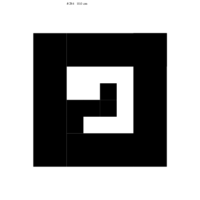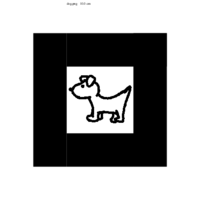Difference between revisions of "Tutorial Fiducials"
m |
m |
||
| Line 10: | Line 10: | ||
In computer vision, a fiducial marker is a known object from which can be identified and its pose estimated. BoofCV provides built in support several different fiducials which can be easily printed. Applications are provided for automatically creating postscript files for the printer and a high level interface for detecting, identifying and pose estimation. | In computer vision, a fiducial marker is a known object from which can be identified and its pose estimated. BoofCV provides built in support several different fiducials which can be easily printed. Applications are provided for automatically creating postscript files for the printer and a high level interface for detecting, identifying and pose estimation. | ||
Square | There are two types of fiducials supported in BoofCV, square and calibration targets. Square fiducials encode a pattern insude a black square box. These targets can be uniquely identified and provide a pose estimate. Calibration targets fiducials are repurposed targets used to calibrate cameras. Calibration fiducials tend to provide very accurate pose estimation when close to the camera, but can have difficulty as they move away. There are two significant disadvantage for calibration targets. 1) They don't provide a unique ID. 2) Most patterns are not fully orientation invariant. You can see the lack of rotation invariance when it suddenly flips 180 degrees. | ||
Calibration targets fiducials are | |||
Summary Table Goes Here | Summary Table Goes Here | ||
| Line 22: | Line 20: | ||
Video | Video | ||
== Square Binary == | == Square Fiducials == | ||
All square fiducials share a common code base. A target contains a black square of constant width and inside there is an image or pattern. The pattern is used to unquely identify the fiducial and determine its orientation. A full 6-DOF pose is estimated from these fiducials. These targets are inspired by ARToolkit, but the code is not a port and was developed from scratched to fully utilize existing code in BoofCV. | |||
The initial processing step is to threshold the image. BoofCV provides a various thresholding texhniques for doing so. FactoryFiducial provides "robust" and "fast" techniques. Robust will use a locally adaptive algorithm which is invariant to local changes in lighting while fast uses a constant threshold. The next step is to find the contour of blobs in the image. Clearly invalid contours are pruned and a polygon fit to the contour. This contour is used to provide the initial estimate of the squares edges. An expectation-maximumization algorithm is used to fit lines to the contour and the corners are found by the intersection of the lines. Once the corners are found a homography is computed and then decomposed to return the pose. | |||
One the pose is known perspective distortion can be used to remove and a synthetic image created. The fiducial is uniquely identified using the synthetic image. Orientation ambiguity is resolved using the fiducials pattern inside the square. For the binary pattern 4 corners are used. For the image 4 different possible orientations are considered and the best match used. | |||
The specifics for each type of square fiducial is discussed below. | |||
=== Square Binary === | |||
The square binary fiducial encodes a 12-bit number, 4096 possible values, using a binary pattern. The number is encoded by breaking up the inner portion into 16 squares in a 4x4 grid. Three of the corners are always white and one black. This is how it resolves an orientation ambiguity. | The square binary fiducial encodes a 12-bit number, 4096 possible values, using a binary pattern. The number is encoded by breaking up the inner portion into 16 squares in a 4x4 grid. Three of the corners are always white and one black. This is how it resolves an orientation ambiguity. | ||
| Line 44: | Line 52: | ||
== Square Image == | === Square Image === | ||
Square image fiducals identify a target by embeding an image inside a square. The theoretical maximum number of unique fiducials is quite large, but in practice is limitted by camera resolution and processing power. The time to process an image increases linearly O(N) with the number images. For a small number of images constant time overhead (binaryization and contour identification) will dominate because images are encoded efficently as binary numbers in integers and fast bitwise operators used to compare. | |||
A fiducial can be created from any image. CreateFiducialSquareImageEPS is used to create new postscript fiducial files and will automatically rescale the image so that it is square and ensure that it's the correct size. For easy of use a Gradle script has been provided: | |||
<syntaxhighlight lang="bash"> | <syntaxhighlight lang="bash"> | ||
gradle fiducialImage -Pwidth=10.0 -Pimage="../data/applet/fiducial/image/dog.png" | gradle fiducialImage -Pwidth=10.0 -Pimage="../data/applet/fiducial/image/dog.png" | ||
Revision as of 15:14, 3 September 2014
- Supported Fiducials
- Calib target chess small.png
Calibration Target
In computer vision, a fiducial marker is a known object from which can be identified and its pose estimated. BoofCV provides built in support several different fiducials which can be easily printed. Applications are provided for automatically creating postscript files for the printer and a high level interface for detecting, identifying and pose estimation.
There are two types of fiducials supported in BoofCV, square and calibration targets. Square fiducials encode a pattern insude a black square box. These targets can be uniquely identified and provide a pose estimate. Calibration targets fiducials are repurposed targets used to calibrate cameras. Calibration fiducials tend to provide very accurate pose estimation when close to the camera, but can have difficulty as they move away. There are two significant disadvantage for calibration targets. 1) They don't provide a unique ID. 2) Most patterns are not fully orientation invariant. You can see the lack of rotation invariance when it suddenly flips 180 degrees.
Summary Table Goes Here
name | Speed | Full Pose | Accuracy
Quick Start
Video
Square Fiducials
All square fiducials share a common code base. A target contains a black square of constant width and inside there is an image or pattern. The pattern is used to unquely identify the fiducial and determine its orientation. A full 6-DOF pose is estimated from these fiducials. These targets are inspired by ARToolkit, but the code is not a port and was developed from scratched to fully utilize existing code in BoofCV.
The initial processing step is to threshold the image. BoofCV provides a various thresholding texhniques for doing so. FactoryFiducial provides "robust" and "fast" techniques. Robust will use a locally adaptive algorithm which is invariant to local changes in lighting while fast uses a constant threshold. The next step is to find the contour of blobs in the image. Clearly invalid contours are pruned and a polygon fit to the contour. This contour is used to provide the initial estimate of the squares edges. An expectation-maximumization algorithm is used to fit lines to the contour and the corners are found by the intersection of the lines. Once the corners are found a homography is computed and then decomposed to return the pose.
One the pose is known perspective distortion can be used to remove and a synthetic image created. The fiducial is uniquely identified using the synthetic image. Orientation ambiguity is resolved using the fiducials pattern inside the square. For the binary pattern 4 corners are used. For the image 4 different possible orientations are considered and the best match used.
The specifics for each type of square fiducial is discussed below.
Square Binary
The square binary fiducial encodes a 12-bit number, 4096 possible values, using a binary pattern. The number is encoded by breaking up the inner portion into 16 squares in a 4x4 grid. Three of the corners are always white and one black. This is how it resolves an orientation ambiguity.
A new fiducial can be created using the DetectFiducialSquareBinary application. For easy of use a Gradle script has been provided:
gradle fiducialBinary -Pwidth=10 -Pnumber=325
:applications:classes UP-TO-DATE
:applications:fiducialBinary
Target width 10.0 (cm) number = 325
101000101000
BUILD SUCCESSFUL
This will create a pattern which is 10cm wide and encodes the number 325. The output will be saved in "boofcv/applications/pattern.eps" file. See the top figure the resulting pattern.
Detection is easy enough using the high level Fiducial interface. See the example below for the details.
Square Image
Square image fiducals identify a target by embeding an image inside a square. The theoretical maximum number of unique fiducials is quite large, but in practice is limitted by camera resolution and processing power. The time to process an image increases linearly O(N) with the number images. For a small number of images constant time overhead (binaryization and contour identification) will dominate because images are encoded efficently as binary numbers in integers and fast bitwise operators used to compare.
A fiducial can be created from any image. CreateFiducialSquareImageEPS is used to create new postscript fiducial files and will automatically rescale the image so that it is square and ensure that it's the correct size. For easy of use a Gradle script has been provided:
gradle fiducialImage -Pwidth=10.0 -Pimage="../data/applet/fiducial/image/dog.png"
:applications:classes UP-TO-DATE
:applications:fiducialImage
Target width 10.0 (cm) image = dog.png
BUILD SUCCESSFUL
This will create a pattern which is 10cm wide and encodes the image contained in 'dog.png'. The output will be saved in "boofcv/applications/fiducial_image.eps" file. See the top figure the resulting pattern.

